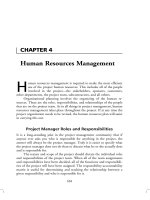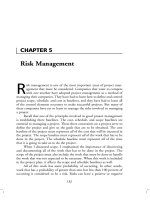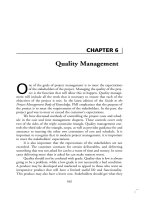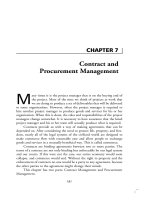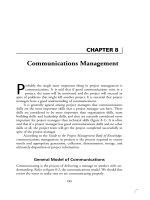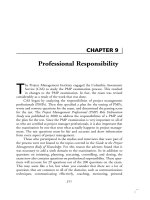Tài liệu Project Management Professional-Chapter 11b (Answer key) doc
Bạn đang xem bản rút gọn của tài liệu. Xem và tải ngay bản đầy đủ của tài liệu tại đây (106.5 KB, 8 trang )
PRACTICE QUESTIONS
ANSWER KEY
9618$$ PRT2 09-06-02 15:00:52 PS
9618$$ PRT2 09-06-02 15:00:53 PS
This Page Intentionally Left Blank
SCOPE MANAGEMENT
1. Answer: b
Scope definition is defined by PMI as ‘‘decomposing the major deliverables into
smaller, more manageable components to provide better control.’’
2. Answer: a
The chart of accounts is the system used to monitor project costs as defined by
PMI.
3. Answer: c
A stakeholder is an individual or organization that is involved in or may be
affected by project activities.
4. Answer: c
The actual payback period is between two years and three years. It is the point
where the net or cumulative cash flows equal zero. This occurs between year 2
and 3 and is 2 and 29/30 of a year from the first cash flow. Cumulative cash
flow in years are: 1, מ500,000; 2, מ290,000; 3, ם10,000.
5. Answer: b
The net cash flow is the total of all the cash flows in and out of the company
caused by the project. In this example 850,000 in and 900,000 out for a nega-
tive 50,000.
6. Answer: b
Calculating the net present value of the cash flows for the project involves
adjusting the future cash flows to allow for diminishing value due to the time
that we must wait to get them. Money received today is more valuable to us
than money that is received in the future.
7. Answer: c
From the Guide to the PMBOK 2000: ‘‘Program. A group of related projects
managed in a coordinated way. Programs usually include an element of ongoing
activity.’’
319
320 Preparing for the Project Management Professional Certification Exam
8. Answer: d
Most of the project money will be spent during the execution phase. At the
beginning of execution the rate of expenditures rises as people and materials are
brought into the project. Later the expenditures peak and slow down. By the
end of the execution phase expenditures are approaching a minimum.
9. Answer: b
From the Guide to the PMBOK 2000: ‘‘Project. A temporary endeavor under-
taken to create a new product or service.’’
10. Answer: c
A statement of work is the description of what the project is about and what
will be delivered. The project plan is complete and contains the detailed work
that the project will do, complete with task descriptions and schedule, cost, and
scope baselines containing a real schedule and budget. An exception report
describes items that are not as planned and a Pareto analysis is a quality manage-
ment tool used to prioritize defects according to those most frequently occur-
ring.
11. Answer: a
Verifying scope is the process of verifying that the project made or delivered is
what was asked for.
12. Answer: d
In management by objectives, the employee and supervisor meet to discuss the
objectives of the employee over the next review period. At the end of the review
period the performance of the employee is reviewed relative to the objectives,
and adjustments are made. This is generally considered a good approach for
project managers to use when managing the project team. In many cases the
review period is as little as two weeks.
13. Answer: c
Configuration management is the process of making sure that the product
meets the design criteria in terms of form, fit, and function.
14. Answer: c
The project charter is one of the first things that must be done in any project.
The project charter according to the Guide to the PMBOK 2000 is: ‘‘A docu-
9618$$ CH20 09-06-02 15:00:58 PS
321Scope Management
ment issued by senior management that provides the project manager with the
authority to apply organizational resources to project activities.’’
15. Answer: c
In the work breakdown structure the lowest level of breakdown is the work
package. This does not mean that work cannot be divided any further. Work
packages are usually broken down into tasks, and tasks can be further broken
down into activities. The point here is that the project manager is concerned
about things down to the work package level. In a relatively large project the
project manager would have subproject managers or work package managers
that would further breakdown the work in their own work breakdown struc-
tures.
16. Answer: c
The current project baseline for scope includes the original scope of the project
plus or minus any scope changes that have taken place since the baseline for
scope was established.
17. Answer: c
A project charter is a document that formally recognizes the existence of a
project. It should include, either directly or by reference to other documents,
the business need that the project was undertaken to address and the product
description.
18. Answer: b
The work breakdown structure represents all the work that must be done in
order to complete the project. Doing all the work will deliver all the tangible
results to the client. In most projects there will also be deliverables that will be
delivered to other stakeholders. Work that is done by contractors and those not
on the project team is included in the WBS. The lowest level of the WBS is
the work package (according to PMI). Work packages can be broken down into
tasks, and tasks can be broken down into activities.
19. Answer: d
A program manager is a manager that manages a group of related projects in a
coordinated way.
20. Answer: b
A work breakdown structure is a deliverable-oriented grouping of project ele-
9618$$ CH20 09-06-02 15:00:59 PS
322 Preparing for the Project Management Professional Certification Exam
ments that organizes and defines the total scope of the project: work not in the
WBS is outside the scope of the project. Although the WBS can and is used for
many other project related things, the best answer is b, since it is the most
comprehensive answer.
21. Answer: b
The execution phase of projects will nearly always cost the bulk of the project
budget. This is because there are more people working on the project, and they
are spending more money than at other times.
22. Answer: a
Progress reports should be used even on the smallest of projects. They allow all
of the stakeholders to judge the performance and progress of the project accord-
ing to the project plan. It is not necessary to use the earned value reporting
system. The overhead of using a formal reporting system may not be justified
on very small projects. Reporting may frequently be delegated to someone on
the project team or even a member of the project management support office.
23. Answer: b
This is the definition of a project.
24. Answer: c
The project charter is the first document to be created in the project. It gives
the project manager the authority to manage the project. It will frequently
contain a business case and a set of goals and objectives for the project as well.
25. Answer: c
Balance is the strength or weakness of the project manager to have authority
over the people who actually do the work in the project. In the projectized
organization the project manager has complete authority over the people on
the project team. In the strong matrix organization the project manager has
more influence over the people on the project team than the functional man-
ager. In the weak matrix organization the functional manager has more author-
ity to direct the project team members than the project manager. In a balanced
matrix organization the project manager and the functional manager are at
about the same authority level.
26. Answer: c
In order for the project to have a 5% probability of being late, there is a 95%
9618$$ CH20 09-06-02 15:00:59 PS
TEAMFLY
Team-Fly
®
323Scope Management
probability that the project will be delivered on time or earlier. In terms of the
PERT calculation this means that 2 standard deviations should be added to the
expected value date of May 30. Since there is a one month difference between
the 95% promise date of June 30 and the expected value of May 30, the stan-
dard deviation must be one-half month. This is a better answer than fifteen
days because on the basis of a five-day work week this is close to three weeks.
27. Answer: c
The request and agreement to a specific date for completion of a particular
milestone in the project is called a constraint. Constraints for project tasks and
activities that do not put them on the critical path are not necessarily a problem
as long as delays in the schedule do not ultimately place them on the critical
path. Some process constraints may be predefined as constraints. For example,
management may specify a target completion date rather than allowing it to be
determined by the planning process. Constraints are factors that will limit the
project management team’s options. For example, a predefined budget is a con-
straint that is highly likely to limit the team’s options regarding scope, staffing,
and schedule.
28. Answer: d
The current budget of the project contains all of the authorized funding for the
project including additions to the project since the setting of the original base-
lines. This includes any and all authorized work done on the project, including
the investigation of work that may be done to investigate the feasibility of
changes.
29. Answer: d
The project manager will normally break the WBS down to the work package
level. Work packages can be broken down further into tasks and activities.
30. Answer: b
It is generally accepted that for most projects, once a project’sdefinitive esti-
mate has been completed, the actual project cost will be not more than 5%
below the definitive estimate and not more than 10% above it.
31. Answer: a
The change management plan is generally a document or procedure that is
normally found in the scope management plan.
32. Answer: a
9618$$ CH20 09-06-02 15:01:00 PS
324 Preparing for the Project Management Professional Certification Exam
The client should pay, because the signing of the WBS constituted an agree-
ment between the company managing the project and the client. Work that is
not specified in the WBS is not part of the project scope. In reality this is
sometimes not the case. Companies will frequently do work that is outside of
the project scope as defined by the WBS in order to ensure the goodwill of the
client.
33. Answer: b
The calculation for net present value is based on the compound interest for-
mula.
FV ס PV ( 1ם r)
n
Where FV is future value and PV is present value.
Solving this for the present value gives:
PV ס FV / (1ם r)
n
NPV סמ50,000 ם (100,000 / 1.1 ) ס 40,909
Note that all the negative cash flows occur at the beginning of the year when
the machine is purchased and that the positive cash flows all occur at the end
of one year.
34. Answer: b
The precedence network diagramming tool is used because it best shows the
logical relationships between the activities in the schedule. The Gantt chart
shows the project schedule graphically indicating the start and finish for each
activity. The milestone chart shows the start or completion for specific groups
of activities on a summarized chart.
9618$$ CH20 09-06-02 15:01:01 PS



